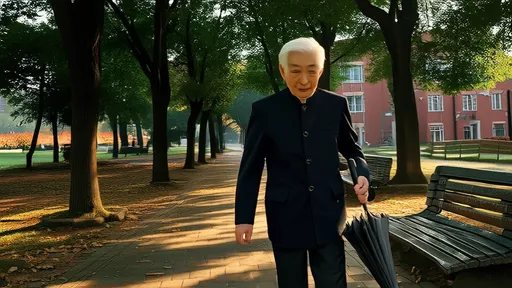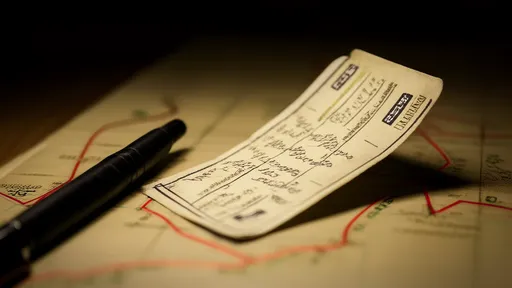The crumpled edges and faded ink on an old train ticket tell stories far beyond their face value. These small paper rectangles, often discarded after a journey, become accidental archives of personal and collective geography. Across continents, generations have tucked them into wallets, pressed them between book pages, or absentmindedly creased them in pockets—each fold marking a moment in time when landscapes rushed past windows and strangers became temporary neighbors.
Railway tickets as cultural artifacts reveal surprising depth when examined not as transit receipts but as tactile maps of human movement. The texture of the paper, the typography of departure cities, even the stains from rain or coffee spills—these elements form a palimpsest of travel before the digital age erased such physical souvenirs. In China, where rail expansion has been both rapid and transformative, tickets from the 1990s show characters pressed through carbon paper, while contemporary magnetic-strip cards document technological leaps alongside shifting place names as cities modernize.
Collectors speak of tickets as fossilized itineraries. A 1987 Beijing-Guangzhou ticket bears witness to when that route took three nights; today’s high-speed trains cover the distance before dinner cools. The yellowing cardstock of Soviet-era Trans-Siberian tickets, with their Cyrillic block letters, outlasted the political system that printed them. Japanese enthusiasts trade Meiji-era stubs that followed the country’s first railways—their delicate rice paper surviving earthquakes and wars.
The geography embedded in these collections isn’t merely about destinations. Fares stamped on tickets trace economic histories: the sudden price spikes during hyperinflation periods, the differential pricing between hard-seat and soft-sleeper classes as social mobility changed. British railcards from the 1984 miners’ strikes show handwritten adjustments when coal shortages altered schedules. Australian collectors prize rare "dogbox" tickets from early 20th-century livestock cars where passengers rode alongside sheep.
Station names as time capsules present their own archaeology. Tickets to "St. Petersburg" became "Petrograd" then "Leningrad" before circling back—a political pendulum swinging in inked letters. Taiwan’s rail tickets still use Japanese-era kanji spellings alongside Mandarin, layering colonial histories. Berlin’s old tickets marked "Hauptbahnhof" in Gothic script before wartime bombs necessitated rebuilding and renaming. The most poignant may be tickets to towns that no longer exist: flooded valleys for dams, communities erased by war, or Soviet "closed cities" that vanished from maps.
Modern ticketing’s dematerialization threatens this accidental archive. QR codes leave no physical trace beyond smartphone screens. Some European collectors now print souvenir replicas of e-tickets, while Japanese rail companies sell decorative replica tickets at station kiosks—acknowledging the nostalgia for tangible proof of journeys. Ironically, the very fragility that made paper tickets seem disposable (their susceptibility to tearing, fading, and loss) ensured their emotional weight; they became keepsakes precisely because they required saving.
The folds themselves tell stories. Diagonal creases reveal tickets carried in shirt pockets during summer journeys when windows still opened. Circular stains on Paris Métro tickets suggest café tables where travelers planned next moves. Tickets from monsoon regions often show water damage at the corners where hands gripped them running through rain. Each imperfection maps a moment no itinerary could record.
Perhaps the most profound collections belong not to hobbyists but ordinary people who simply never threw tickets away. A Shanghai professor’s tin box holds every ticket from his 40-year commute, documenting how the city sprawled outward. A retired German nurse keeps hers threaded on strings like geographic rosaries—Munich to Hamburg in 1962, Hamburg to Rostock in 1989—each knot a life chapter. These private archives capture something official histories miss: the intimate scale of how geography shapes us, one departure at a time.
As high-speed rail networks shrink continents and contactless payments erase paper trails, the humble train ticket’s second life as cultural artifact reminds us that every journey leaves two tracks: one on the rails, and another in memory’s fragile landscape. The collectors preserving these paper fragments aren’t just archiving transit history—they’re safeguarding evidence of how we’ve moved through time as much as space, with creases recording bends in the road we’ve traveled together.

By /Jul 15, 2025

By /Jul 15, 2025

By /Jul 15, 2025

By /Jul 15, 2025

By /Jul 15, 2025

By /Jul 15, 2025

By /Jul 15, 2025

By /Jul 15, 2025

By /Jul 15, 2025

By /Jul 15, 2025

By /Jul 15, 2025

By /Jul 15, 2025

By /Jul 15, 2025

By /Jul 15, 2025

By /Jul 15, 2025

By /Jul 15, 2025

By /Jul 15, 2025

By /Jul 15, 2025